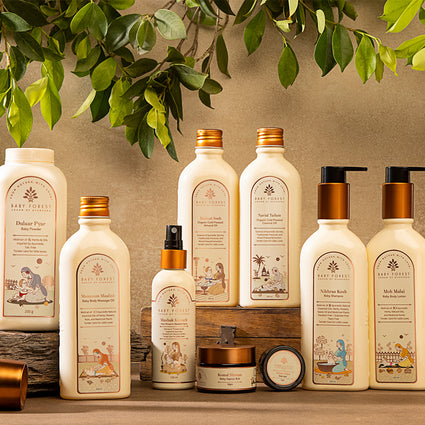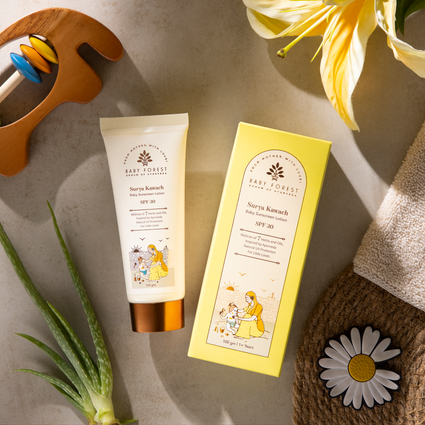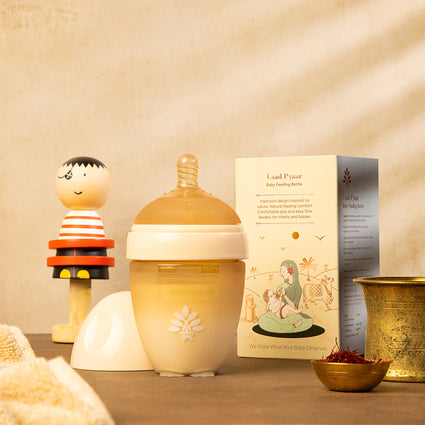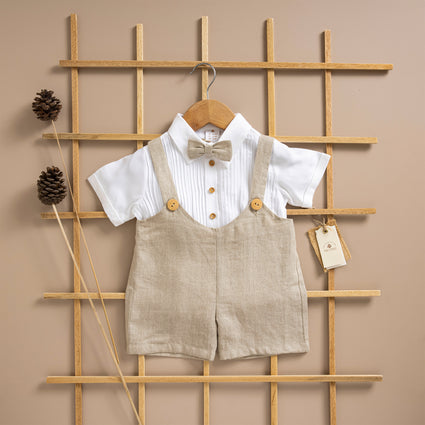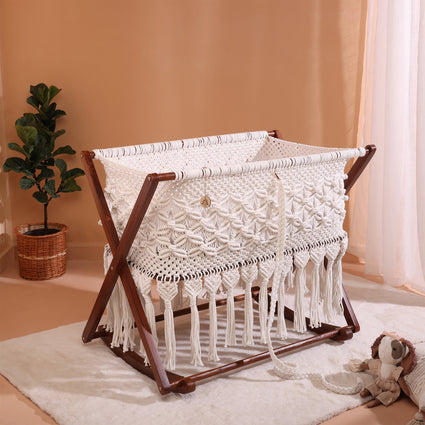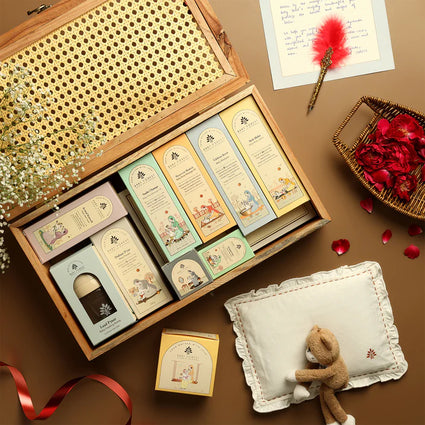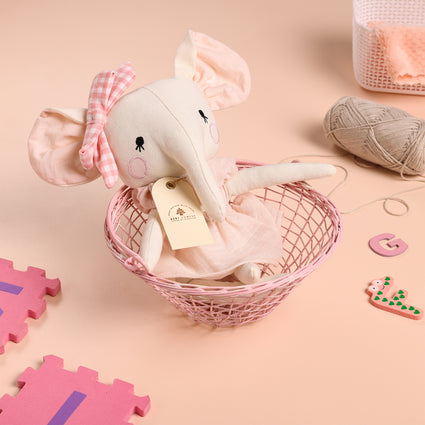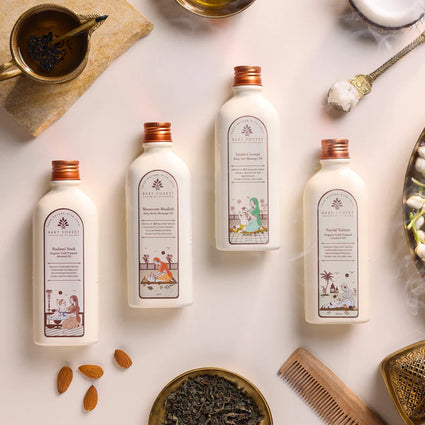Baby Care & Parenting Blogs
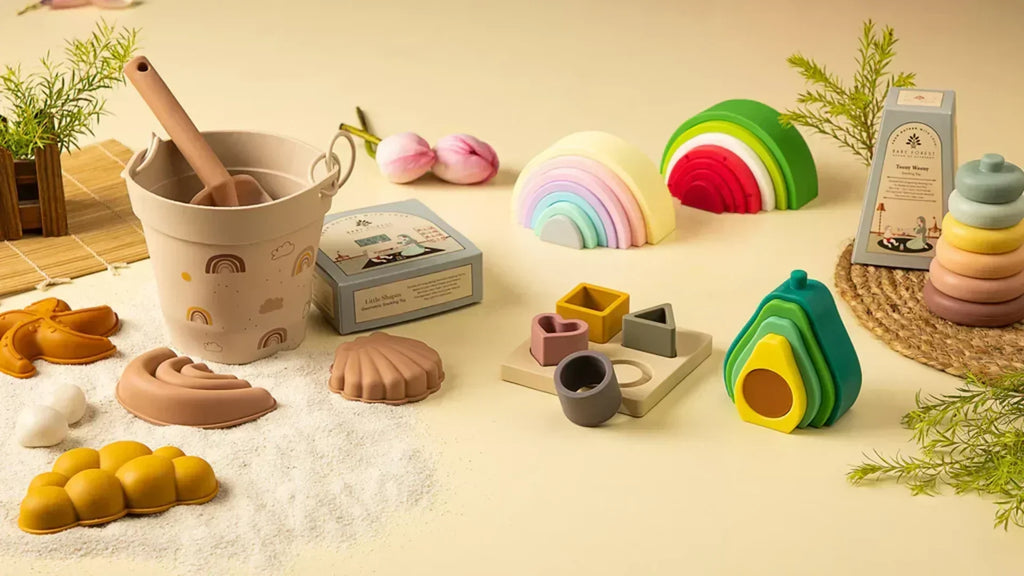
Things to Keep in Mind Before Buying Baby Toys
Choosing toys for babies is so exciting, isn’t it? But with all the options out there, it can also feel a bit overwhelming. Toys aren’t just fun; they play a key role in your baby’s development, helping with physical, cognitive, and emotional growth. But with all the excitement, you also have the responsibility to pick the right ones. So, how do you choose the best baby toys?
This toy-buying guide takes you through important considerations, ensuring that the toys you pick are safe, educational, and fun for your lil one.
What are some considerations while purchasing baby toys?

Safety Standards
Safety comes first when you’re thinking about how to buy safe toys for your baby. All toys should be tested for toxic materials, choking hazards, and other risks. Be extra cautious with baby toys that have tiny pieces, sharp edges, or parts that could come off. Even when you buy baby toys that meet safety standards, supervision is always a must!
Age-Appropriate Toys
It’s super important to choose toys based on your baby’s age. Most toys will have an age recommendation on the packaging. It’s your starting point for selecting toys that fit your baby’s stage of growth. For example, soft crochet toys are great for newborns, while stacking toys are perfect for toddlers who’ve started developing fine motor skills. This is a great way to ensure that toys are both fun and safe for your little one.
Material and Construction
Since babies love to put toys in their mouths, the material is key. Always opt for non-toxic, BPA-free toys. Wooden toys like a wooden car toy or a wooden spinning lattu are fantastic choices. They’re durable, safe, and typically free from harmful chemicals. Also, make sure the toy is well-made. You don’t want parts breaking off and creating a choking hazard.
Educational Value
Toys are an excellent tool for learning. When you buy baby toys, look for those that offer educational value. Choose toys that help your baby develop cognitive skills, problem-solving, and creativity. Simple puzzles and shape sorters, for example, are great for developing hand-eye coordination and spatial awareness. Playtime should be both fun and a stepping-stone for learning!
Stimulating Senses
Babies explore the world through their senses, so choose toys that engage sight, sound, touch, and even taste safely. Brightly coloured toys, gentle-sounding toys, textured toys, and those safe to chew on are all perfect for stimulating their senses. Crochet toys are especially great for tactile exploration, thanks to their varied textures and softness.
Versatility and Longevity
You don’t want to buy toys that your baby will outgrow in a few months. Look for toys that can grow with your child. Toys that offer new ways to play as your baby gets older are great investments. A beach munchkin bucket, for example, can be used for simple fill-and-dump play when your baby is young, but as they grow, it can be used for imaginative play and learning about quantities.
Easy to Clean
Babies love to make messes, so it’s essential to choose toys that are easy to clean. Look for options that can be wiped down easily or, even better, machine washable. This is especially important for toys your baby chews on or uses during meals or bath time. Keeping your baby’s toys clean helps prevent germs and keeps them safe and healthy.
Final thoughts
Choosing the right toys for your baby is all about balancing fun and responsibility. Keep in mind the age appropriateness, safety standards, material, construction, educational value, sensory stimulation, versatility, longevity, and ease of cleaning. By considering these factors, you can make smart choices that will benefit your baby’s growth and provide you peace of mind.
Whether it’s a wooden car toy, a crochet toy, or a beach munchkin bucket, every toy has the potential to be a great addition to your baby’s playtime. Remember, the best toys are those that engage your baby’s senses, encourage learning, and, above all, are safe and fun to play with. So, next time you’re wondering how to buy safe toys for your little one, or looking for tips on the best toys, consider these factors to ensure you’re making the best choices. Buy baby toys online with confidence and keep your baby’s development in mind as you shop!
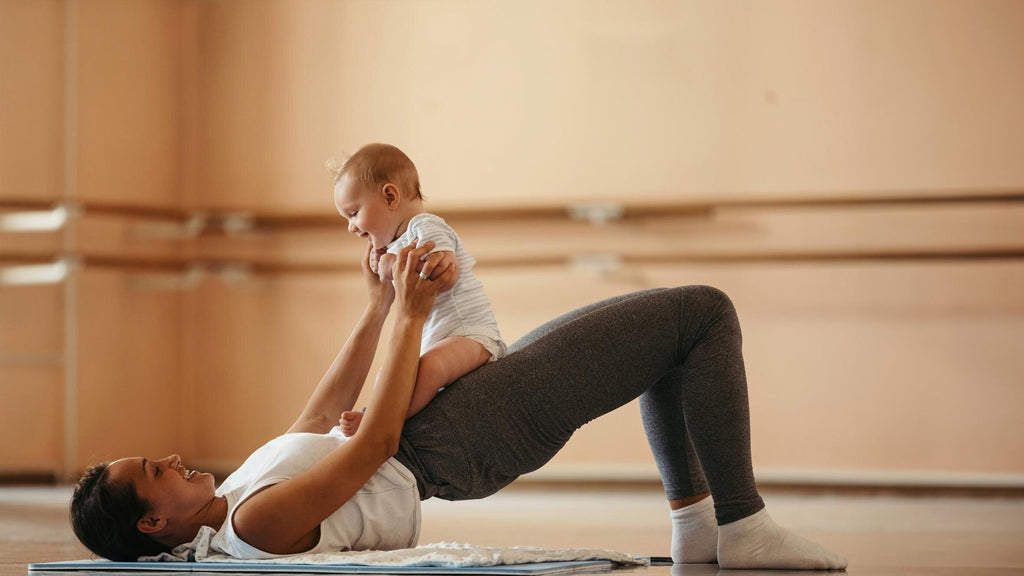
A Parent’s Guide to Dressing Your Baby for Cold Weather
Winter brings its own charm, with chilly breezes and cosy moments. But for parents, it also brings the challenge of keeping their little ones warm and comfortable. Babies, especially newborns, are more sensitive to cold weather because they can’t regulate their body temperature as well as adults. So, knowing how to dress your baby properly for the cold is essential to keep them snug, safe, and happy.
This guide will walk you through the essentials of dressing your baby for cold weather, ensuring they stay cosy without feeling overheated or uncomfortable.
When it comes to dressing your baby for winter, keeping them warm and cozy doesn’t have to mean piling on too many layers. The key is to choose clothing that provides full coverage and warmth without needing excessive layering.
Start with a single warm outfit, like a Full Sleeves Baby Bodysuit, a Hoodie Romper Set, or a Baby Overall Romper Set. These options are designed to cover your baby’s arms, legs, and feet, often including attached socks and mittens, so they’re well-protected from the cold.
If it’s particularly chilly or you’re stepping outside, add an extra layer like a Kashmiri Pashmina Baby Blanket to wrap them snugly. This provides an additional shield against the cold without making your baby feel restricted or overheated. Remember, it’s all about keeping them comfortable while ensuring they’re safe from the winter chill.

-
Choose the Right Materials
The type of fabric you choose for your baby’s winter wardrobe can make a big difference in keeping them comfortable. Here are some fabrics to prioritize:Cotton:
Perfect for base layers like bodysuits, as it’s soft, breathable, and gentle on sensitive skin.Wool or Fleece:
Ideal for outer layers, these materials provide excellent insulation. Look for fleece-lined rompers like the Hoodie Romper Set for extra warmth.Pashmina:
A premium choice for blankets, offering warmth without bulk.Knitted Wool:
Great for hats and mittens, as it’s warm yet breathable.
Avoid synthetic materials that can irritate your baby’s skin or cause overheating. -
Dressing for Sleep
Nighttime can be tricky when it comes to keeping your baby warm. You want to ensure they’re snug but not too hot. Start with a Full Sleeves Baby Bodysuit as the base layer, followed by a lightweight sleep sack or swaddle.

Always check the temperature of the room and avoid heavy bedding like quilts, which can pose a suffocation risk. A safe sleep environment is just as important as keeping your baby warm. -
Keep an Eye on Overheating
While it’s crucial to keep your baby warm, it’s equally important to avoid overheating. Overdressing can make your baby uncomfortable and increase the risk of heat rashes or even more serious issues. Signs of overheating include sweating, flushed cheeks, or a damp neck.
A simple rule to follow is the one-layer rule: dress your baby in one more layer than what you’re wearing to stay comfortable in the same temperature. -
Protect Their Head and Ears
Babies lose a lot of heat through their heads, so don’t forget a soft, snug-fitting hat. If you’re heading outdoors, ensure their ears are covered to prevent them from getting too cold. Many rompers, like the Hoodie Romper Set, come with attached hoods that can be used for added warmth. -
Check Comfort Regularly
Even when your baby looks cosy, it’s essential to check how they’re feeling. Feel their chest or back (not hands or feet, as they can naturally feel cooler) to ensure they’re warm but not sweaty. Adjust their clothing or layers accordingly.
Final Thoughts
Dressing your baby for winter isn’t just about keeping them warm; it’s about making sure they feel cozy, comfortable, and cared for. Don’t worry if you’re still figuring it out—dressing your baby is something you’ll get better at with time. Enjoy the snuggles, the giggles, and those quiet moments as you wrap them up against the cold.

8 Must-Have Festive Clothing for Your Little One
Festive seasons are all about joy, celebration, and dressing up. And while you’re picking out your best outfits, don’t forget about your little one! Dressing up your baby in cute, festive clothing can add an extra sparkle to the celebrations. But with so many options out there, it can be hard to know where to start. That’s why we’ve put together a list of 8 must-have festive clothing items for your little one. These outfits are not only adorable but also comfortable, so your baby can enjoy the festivities as much as you do.
-
Checkered Frilled Baby Girl Dress
If there’s one dress that screams festive, it’s the Checkered Frilled Baby Girl Dress. This dress is perfect for special occasions, with its classic checkered pattern and delicate frills that add a touch of elegance. The soft fabric ensures your baby is comfortable throughout the day, while the frills give the dress a playful look. It’s a versatile piece that can be paired with cute accessories like a headband or tiny ballet flats to complete the festive look. -
Dress with Embroidered Jacket
For those cooler festive evenings, a Dress with an Embroidered Jacket is a perfect choice. The dress itself is simple and comfortable, but the embroidered jacket adds a layer of warmth and style. The intricate embroidery on the jacket gives it a traditional touch, making it suitable for cultural or religious celebrations. Plus, the jacket can be removed if it gets too warm, giving your baby girl the flexibility to move around comfortably. -
Hand Embroidered Gather Top with Underpants
This outfit is both adorable and practical, making it a must-have for your baby’s festive wardrobe. The Hand Embroidered Gather Top with Underpants is designed with delicate embroidery that adds a festive flair, while the gathered top provides a comfortable fit. The matching underpants make it easy to dress your baby without worrying about mismatched bottoms. -
Solid Dress and Embroidered Jacket Set
A Solid Dress and Embroidered Jacket Set is another excellent option for festive occasions. The solid-coloured dress is simple yet elegant, making it a versatile piece that can be worn on its own or with the embroidered jacket. The jacket adds a festive touch with its detailed embroidery, making the outfit suitable for more formal events. This set is also great for layering, so your baby stays warm and stylish no matter the weather. -
Baby Dungaree Set
Dungarees are timeless pieces of clothing that can be dressed up or down, making them a great addition to your baby’s festive wardrobe. This set comes with a cute inner t-shirt, making it an easy outfit to throw on when you’re in a hurry. Pair it with tiny sneakers or boots for a complete festive look for your baby boy that’s perfect for outdoor gatherings. -
Cotton Linen Romper Set
When it comes to festive clothing for babies, comfort is key, especially for babies. The Cotton Linen Romper Set offer just that, with its soft, breathable fabric that’s gentle on your baby’s skin. This set is perfect for warmer climates or indoor celebrations where you want your baby to stay cool and comfortable. The romper is easy to put on and take off, making diaper changes a breeze. Plus, the simple design allows you to accessorize with a festive hat or booties. -
Embroidered Shirt with Trouser Set
For a more traditional look, the Embroidered Shirt with Trouser Set is a fantastic choice. This outfit combines the classic style of a button-down shirt with the festive flair of embroidery. The trousers are designed to be comfortable yet stylish, allowing your baby to move around freely. This set is ideal for formal events or religious ceremonies where you want your little one to look their best. Pair it with tiny loafers to complete the sophisticated look. -
Checkered Shirt with Off-White Cotton Linen Romper Set
Last but not least, the Checkered Shirt with Off-White Cotton Linen Romper Set is a must-have for any festive occasion. The checkered shirt adds a fun and playful element, while the off-white romper keeps the look crisp and clean. The cotton linen fabric ensures that your baby stays comfortable, even during long celebrations. This outfit is perfect for daytime events and can be easily dressed up with a cute bow tie or down with a simple pair of sandals.
Tips for Choosing Festive Clothing for Your Baby
When selecting festive outfits for your little one, comfort should always be your top priority. Babies can get fussy if they’re uncomfortable, so choose soft fabrics that are gentle on their skin. It’s also a good idea to opt for outfits that are easy to put on and take off, as this will make diaper changes much easier during the festivities.
Another tip is to choose outfits that offer some flexibility. Many of the options mentioned above come with layers, like jackets or rompers, which can be added or removed depending on the weather. This way, your baby can stay comfortable whether you’re celebrating indoors or outside.
Lastly, don’t forget to have fun with your baby’s festive wardrobe! Festivals are a time for joy and celebration, and dressing up your little one is all part of the fun. Mix and match different pieces, add cute accessories, and take lots of photos to capture these precious moments. After all, these moments are ones you’ll treasure for years to come.
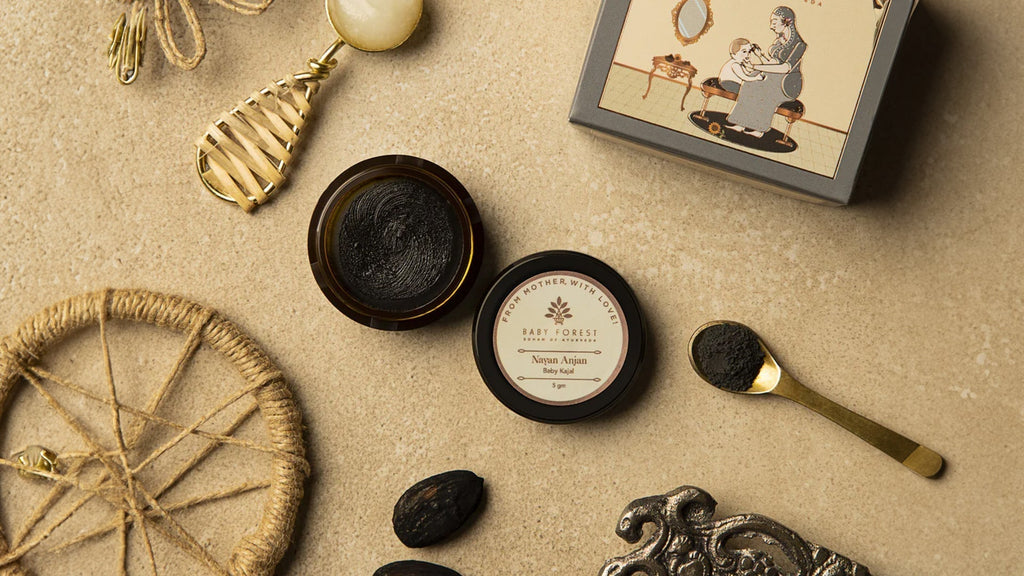
Kajal Application for Newborns: Tips for Safety and Hygiene
Bringing a newborn into the world is a magical experience, and as parents embark on this journey, they are often flooded with advice, especially when it comes to caring for their little ones. One age-old tradition that has been passed down through generations is the application of kajal to a newborn's eyes.
This practice is not just a cultural norm; it is believed to have various benefits for the baby's eyesight and overall well-being. However, in this modern age, where safety and organic choices are paramount, it's essential to navigate this tradition with care.
In this article, we'll explore the significance of using kajal for newborns and offer valuable tips on safety and hygiene.
Why Do We Put Kajal on Babies?
The practice of applying kajal to babies has profound cultural roots and is deeply rooted in tradition in many communities. While the reasons may vary, the common belief is that applying kajal to a newborn's eyes holds several symbolic and practical benefits:
Cultural and Traditional Significance:
Many cultural and religious rituals involve the application of kajal to signify blessings and protection. It's often seen as a gesture of love and care, passed down through generations as a cherished tradition that connects families to their cultural heritage. One of the primary reasons behind applying kajal on a newborn baby is to protect them from the "evil eye." Kajal is thought to act as a protective barrier in many cultures, deflecting any harmful intentions.
Enhancing Facial Features:
The dark outline created by Kajal is also seen as a way to enhance the baby's facial features. It is believed to highlight the beauty of the eyes, making them appear larger and more captivating.
While the cultural significance of applying kajal on newborn babies is deeply rooted, it's important for modern parents to approach this tradition with a balance of cultural respect and contemporary awareness.
Choosing organic kajal for newborns and following safe application practices can help preserve the tradition while prioritizing the health and well-being of the newborn. Always keep in mind that cultural practices evolve and adapting them to modern standards ensures a harmonious blend of tradition and informed parenting.
Choosing the Right Kajal for Babies:
Opting for organic kajal for newborn babies is a wise decision for parents who prioritize their baby's health. Traditional kajal products may include toxic ingredients that may irritate the delicate skin around the eyes. Look for certified organic kajal, free from parabens, artificial fragrances, and other harsh additives.
These products are specially designed to be mild on a baby's sensitive skin, lowering the chance of irritation or allergies. Our Nayan Anjan Baby Kajal is infused with ayurvedic essential oils and nuts that provide nourishment and protect your baby's eyes.
Tips for Safe Application:
Wash Your Hands:
Before you start, it's essential to wash your hands thoroughly. This helps prevent the transfer of any germs or dirt to your baby's face during the application process.
Choose the Right Time:
Pick a time when your baby is calm and alert. Trying to apply kajal when your baby is fussy may lead to a challenging experience for both of you.
Use a Clean Applicator:
Opt for a clean, soft cotton swab or a specially designed kajal applicator. Ensure that it is only used for your baby's eyes to maintain hygiene.
Be Gentle:
Gently pull down the lower eyelid and apply a small amount of organic kajal along the waterline. Avoid applying kajal on the eyelashes or upper eyelids to prevent any product from entering the eyes.
Check for Red Flags:
Keep a close eye on your baby's reaction during and after the application. If you observe any signs of pain, redness, or inflammation, immediately remove the kajal and visit your pediatrician.
Maintain Hygiene:
Regular Cleaning:
Clean the applicator after each use and store the organic kajal in a cool, dry place. This inhibits the growth of bacteria and ensures that the product is safe for your baby's sensitive eyes.
Check Expiry Dates:
Organic products may have a shorter shelf life, so always check the expiry date before using the kajal. Using expired products can pose risks to your baby's health.
Avoid Sharing:
Never share your baby's kajal with others. Each baby's eyes are unique, and sharing kajal may lead to cross-contamination and potential infections.
What should be done if kajal causes irritation or an allergic reaction?
If the baby kajal causes irritation or an allergic reaction in your newborn, immediately stop using the product. Clean the affected area with warm water and a soft cloth to remove any remaining kajal. If the irritation persists or you notice any signs of infection such as redness, swelling, or discharge, consult a pediatrician promptly. It's crucial to address any adverse reactions early to prevent further complications.
Common Myths and Truths Related to Applying Kajal to Baby's Eyes
Myth 1: Kajal improves eyesight.
Truth: No scientific evidence supports the claim that kajal can improve a baby's eyesight. Eye health is best maintained through proper hygiene and regular check-ups with a pediatrician.
Myth 2: Kajal protects against the evil eye (Nazar).
Truth: The belief that kajal protects against the evil eye is a cultural tradition without scientific backing. While respecting cultural practices is important, ensuring the safety of the product used on a baby's skin and eyes is crucial.
Myth 3: Homemade kajal is always safe.
Truth: While homemade kajal can be free from harmful chemicals, it poses risks if not prepared in a hygienic environment. Ensuring that any ingredients used are safe and non-irritating for a newborn's sensitive skin is essential.
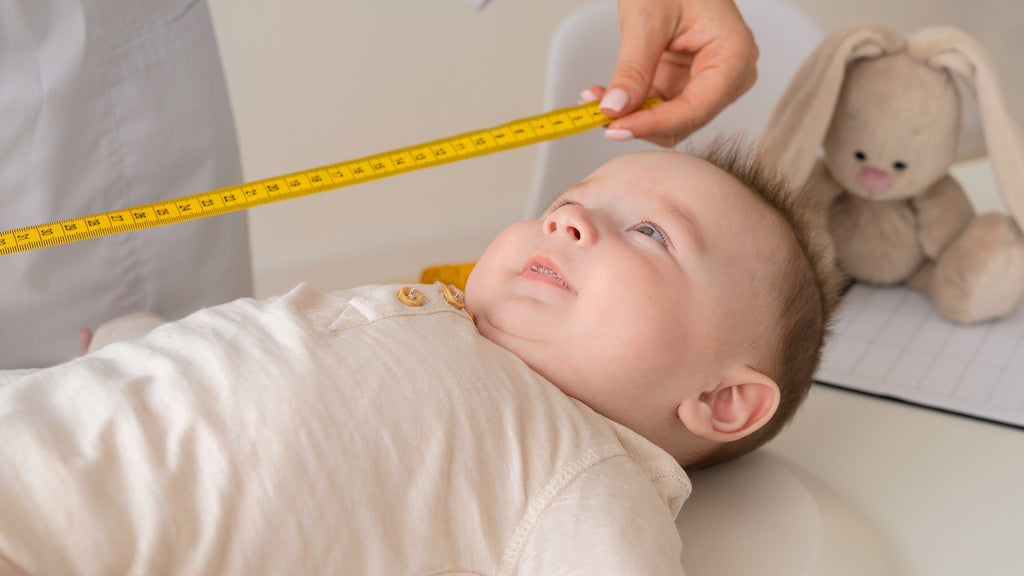
Importance of Baby Growth Chart for a Parent
Parenthood is a journey filled with joys, challenges, and countless milestones. Monitoring your baby's growth and development is crucial to ensuring their health and well-being. This is where a baby growth chart comes into play. A baby growth chart is vital for parents and healthcare providers to track a child's physical development over time. It helps understand whether your baby is growing at a healthy rate compared to established norms.
What is a Baby Growth Chart?
A baby growth chart visually represents your child's growth patterns over a period. It includes weight, height (or length), and head circumference measurements. These charts are created based on data from a large population of children and provide percentiles that indicate how your baby's measurements compare to others of the same age and sex.

Why is a Baby Growth Chart Important?
-
Tracking Developmental Milestones
A baby growth chart allows parents and healthcare providers to track important developmental milestones. By comparing your baby's growth to standard growth patterns, you can ensure they are developing healthily. -
Early Detection of Health Issues
Deviations from typical growth patterns can be an early indicator of health problems. For instance, if your baby's weight gain slows significantly, it might signal nutritional issues or underlying medical conditions requiring attention. -
Personalized Care
Growth charts help in providing personalized care. By closely monitoring your baby's growth chart, healthcare providers can offer tailored advice on nutrition, physical activity, and overall health care.
Understanding the Baby Growth Chart During Pregnancy
While most parents are familiar with tracking their baby's growth post-birth, the pregnancy baby growth chart is equally important. During pregnancy, regular ultrasounds and check-ups provide data on the fetus's growth, helping to ensure that the baby is developing properly inside the womb. This pregnancy baby growth chart includes measurements like fetal length and weight compared to standard fetal growth patterns.
How to Use a Baby Growth Chart
-
Regular Check-ups
It's important to take your baby for regular pediatric check-ups, where the doctor will measure and plot your baby's growth. This helps maintain an accurate baby growth chart. -
Understand the Percentiles
Growth charts use percentiles to compare your baby's growth to other children's. For example, if your baby boy's weight is in the 50th percentile, it means he is heavier than 50% of boys his age and lighter than the other 50%. The baby boy and girl growth charts will have different percentiles based on sex-specific growth data. -
Consistent Monitoring
Consistent monitoring helps identify deviations from the expected growth patterns early. Keeping track of your baby's measurements at home between doctor visits can be helpful.
Interpreting the Growth Chart of Your Baby
Interpreting your baby's growth chart involves understanding where your baby falls on the chart. It's essential to recognize that each baby grows at their own pace. Some might be naturally smaller or larger than others. What matters most is that your baby consistently grows over time.
-
Weight:
Monitoring your baby's weight is crucial as it reflects their overall health and nutrition. Regular updates on the baby growth chart will show if your baby is gaining weight at a healthy rate. -
Height/Length
Tracking your baby's height or length helps in assessing their skeletal growth. The growth chart will indicate if your baby is growing taller than expected. -
Head Circumference:
Measuring head circumference is essential for monitoring brain development. This measurement on the baby growth chart can help detect any potential issues with brain growth or skull development.
Gender-Specific Growth Charts
There are differences in growth patterns between boys and girls, which is why there are separate baby boy growth charts and baby girl growth charts. These charts account for the average growth differences and help in making more accurate assessments.
For example, a baby boy growth chart might show that boys typically have a slightly higher weight and height compared to girls at certain ages. Conversely, a baby girl growth chart will reflect the average growth patterns specific to girls. Using the correct chart ensures that you are comparing your baby's growth to the appropriate standards.
The Role of Nutrition
Nutrition plays a critical role in your baby's growth. A well-balanced diet rich in essential nutrients supports healthy growth and development. Consulting with a pediatrician to ensure your baby's diet meets their nutritional needs is crucial, especially if the baby's growth chart indicates any concerns.
Conclusion
A baby growth chart is more than just a set of numbers and percentiles. It's a vital tool for ensuring your child's healthy development and early detection of potential health issues. By regularly monitoring your baby's growth chart, you can provide the best possible care and support for the baby's growth journey.
Whether you are tracking the pregnancy baby growth chart during prenatal visits or the baby boy growth chart and baby girl growth chart after birth, understanding and using these charts effectively is key to your baby's health. Remember, every child is unique, and growth patterns can vary widely, so always consult your healthcare provider for personalized advice and guidance.
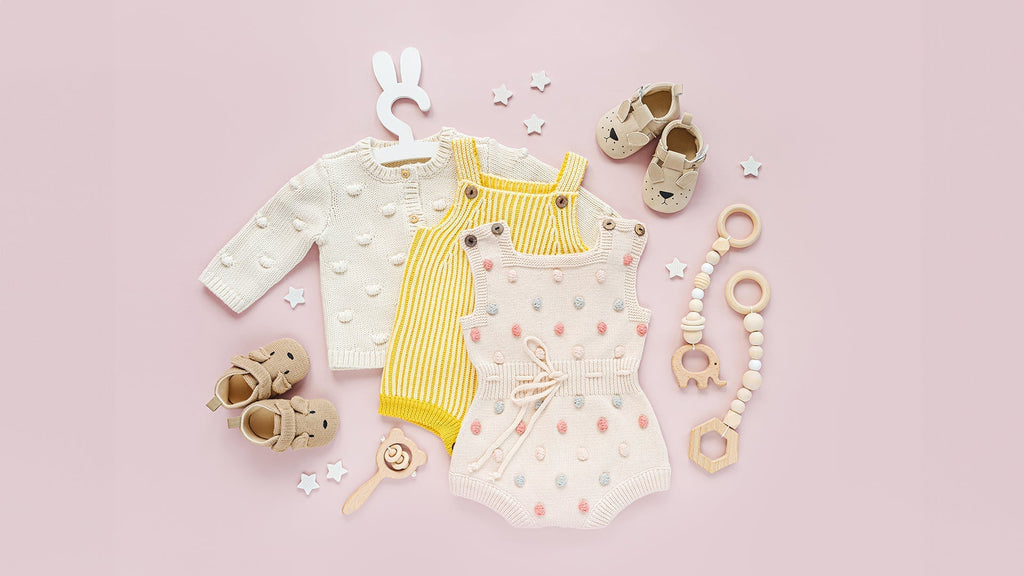
6 Must-Have Newborn Clothes for the First Few Months
Picking out clothes for a newborn can be overwhelming for new parents, especially with the vast array of adorable options online. It's important to choose the right newborn baby clothes that aren't just cute but are also comfortable for your baby and practical for you. In the first few months, your baby will need garments that are soft, easy to put on, and made from skin-friendly materials. Organic cotton is a top choice because it's gentle on your baby's sensitive skin and free from harsh chemicals.
Why Choose Organic Clothing for Your Newborn?
When it comes to newborn clothing, the fabric's safety and comfort are paramount. Organic cotton is a stellar choice for your baby's delicate skin. Grown without harmful chemicals and pesticides, organic cotton is not only softer but also much gentler than conventional cotton. It's hypoallergenic, highly breathable, and incredibly comfortable, making it perfect for protecting your baby's sensitive skin. Plus, it's durable and holds up well after many washes—essential for baby clothes that need frequent cleaning. Organic cotton clothes aren't just better for your baby; they're also better for the environment.
Essential Newborn Clothes for the First Few Months
Let's dive into the must-have newborn clothes that combine style, comfort, and practicality, all crafted from organic cotton to ensure your baby's comfort and health.
-
Overlap Knotted Bodysuit
This amazing piece of clothing is perfect for newborns. The overlap design ensures that the fabric does not irritate the umbilical cord stump, and the knotted bottom makes diaper changes quick and hassle-free. Its soft, stretchy material allows for easy movement and adjustment, accommodating your baby's rapid growth.
-
Hand-Embroidered Bodysuit
Add a touch of charm and tradition to your baby's wardrobe with a hand-embroidered bodysuit. These bodysuits feature delicate designs that are gentle on the skin, avoiding the underside embroidery that can scratch. They are as practical as they are beautiful, ensuring your baby looks lovely while staying comfy.
-
Pleated Ruffle Baby Girl Romper
The pleated ruffle romper is a delightful choice for your baby girl. This romper combines the practicality of a bodysuit with the style of a dress, making it ideal for outings or family gatherings. The snaps at the bottom allow for easy diaper changes, while the organic cotton fabric keeps your baby cool and comfortable.
-
Baby Bodysuit Set
A set of several simple bodysuits is indispensable for any newborn's wardrobe. Opt for sets that include various patterns and colours to keep your baby looking fresh and sweet. These sets ensure you have a clean outfit on hand at all times, which is essential given the surprising number of times babies can go through clothing in a day. Buy our baby bodysuit set made from 100% organic cotton and includes a matching cap, mittens, and booties for the baby.
-
Smocked Embroidery Baby Girl Bodysuit
The smocked embroidery bodysuits add a vintage charm without compromising comfort. The embroidery is carefully positioned and backed to ensure it doesn't irritate your baby's skin. These bodysuits are perfect for when you want to dress up your little one for photos or special occasions.
-
Overlap Baby Bodysuit
Another excellent everyday option is the overlap baby bodysuit, which features panels that fold over each other, making dressing and undressing easier—a boon for parents and comfortable for babies. These bodysuits are perfect for layering and come in a variety of colours that make mixing and matching fun.
Additional Tips for Choosing Newborn Clothes
When shopping for newborn clothes, always look for features that offer convenience and comfort. Choose garments with snaps and zippers that make changing easier and avoid clothes with tight elastic bands that can pinch or bind.
Dressing your newborn can be one of the many joys of new parenthood, especially when you have the right clothes at your disposal. By opting for garments made from organic cotton, you can ensure your baby's comfort and health are never compromised. These essentials not only meet the practical needs of caring for a newborn but also envelop your baby in softness and style, making those first few months even more special. Remember, while the days might feel long, the years are short, so cherish these early moments in outfits that are as tender on your baby's skin as your touch.
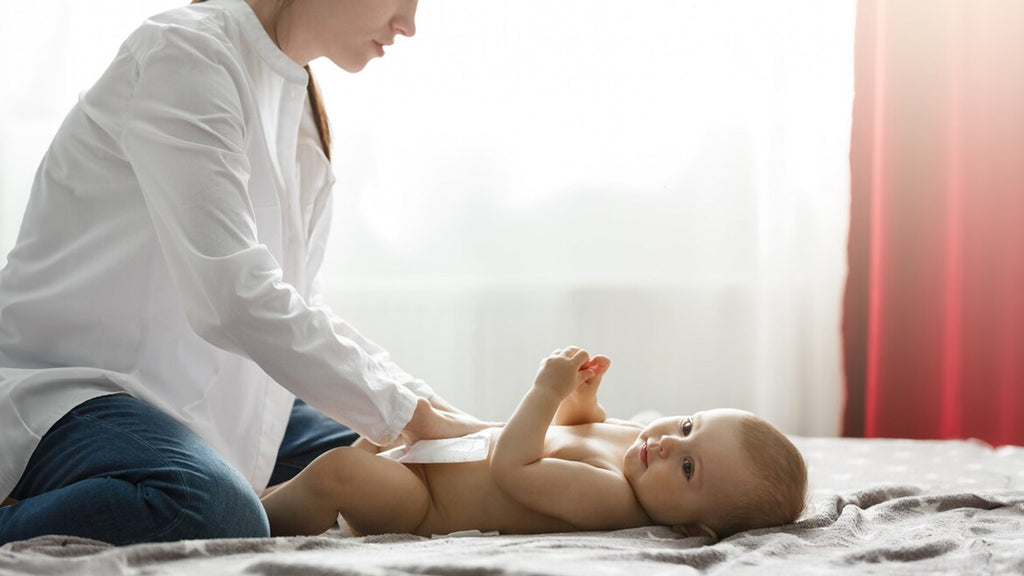
What Does Your Baby's Poop Color Mean?
As a new parent, you quickly learn that baby poop has a wide array of colours, and each hue can tell you something about your baby's health. Understanding what different poop colours might indicate is an essential aspect of monitoring your baby's wellbeing. Here's an extensive guide to what various baby poop colours mean, including insights that could help you decide when a visit to the paediatrician might be necessary.
What Do Different Baby Poop Colours Mean?
Mustard Yellow:
For babies who are breastfed, mustard yellow is the most common colour of poop. It's usually soft, loose, and might have seed-like particles. This colour is normal and indicates that your baby is digesting breast milk well.
Dark Green:
In formula-fed babies, poop often turns dark green. This colour can also appear in breastfed babies given iron supplements or if the mother consumes a significant amount of green leafy vegetables. Dark green poop is typically thicker than that of breastfed babies. It's normal and not a cause for concern unless accompanied by other unusual symptoms.
Bright Green:
Bright green poop can occur in both breastfed and formula-fed babies. It could occur if the baby is eating too quickly, consuming a lot of lactose from milk (foremilk), and not getting enough of the fattier milk that arrives later in the feeding (hindmilk). It can also be a sign of a virus. If bright green stool persists, consult a paediatrician to rule out any digestive issues.
Brown:
As babies start to eat solids, their poop typically transitions to brown. This is a normal development and indicates that your baby's digestive system is handling new foods. The consistency and exact shade of brown might vary depending on the diet.
Orange:
Orange poop can be seen in babies who are just starting on solids. It's often a result of digesting food like carrots or sweet potatoes. It's generally nothing to worry about unless the stool seems unusually loose, or your baby shows discomfort.
Black:
Black stool in newborns during the first few days is called meconium and is perfectly normal. However, if black poop occurs after the meconium stage, it could indicate bleeding in the upper gastrointestinal tract. If your baby's poop is black (and it's not meconium), you should contact your paediatrician immediately.
White:
White or very pale stool can indicate a bile duct blockage. Stools get their characteristic brown colour from bile, a digestive fluid produced by the liver. Lack of bile can indicate a serious problem, and white stool warrants an immediate call to your paediatrician.
Red:
Seeing red in your baby's diaper can be alarming. Red can signify that there is blood in the stool. This might be due to a milk allergy, a small anal fissure (crack), or something more serious like an intestinal infection. If you notice red poop, it's best to consult a paediatrician to understand the cause.
When to Worry About Baby Poop Color
While variations in poop colour can be normal, certain colours might indicate health issues:
Black, White, or Red Poop:
As mentioned, these colours can signify more serious conditions and should prompt an immediate call to your paediatrician.
Consistent Changes in Color:
Sudden and persistent changes in stool colour can also be a sign of dietary reactions or health issues.
Accompanying Symptoms:
If unusual poop colour is accompanied by other symptoms like fever, vomiting, lethargy, or irritability, it might be time to visit your doctor.
Tips for Monitoring Baby Poop
Keep a Diaper Diary:
Track your baby's poop colours and textures to notice patterns or changes over time.
Notice Other Symptoms:
Always consider the overall wellbeing of your baby. Are they feeding well? Do they seem unusually upset? These clues can help you determine if a poop colour is part of a larger issue.
Consult Your Pediatrician:
When in doubt, always consult your pediatrician. They can provide guidance and peace of mind.
Conclusion
Monitoring the colour of your baby's poop is a practical way to keep tabs on their health. Most variations are normal, especially with changes in diet. But knowing what each colour can represent will help you take preventative measures for your child's health and make sure they get the right care when they do. Remember, you know your baby best, and noticing changes in their poop can be one of the first signs that they might need a little extra attention.
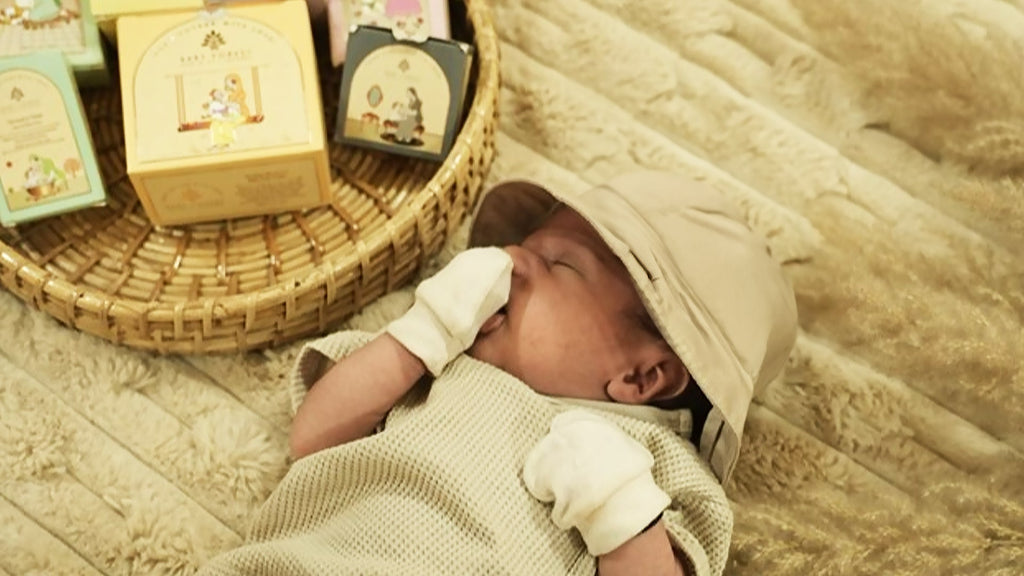
How to Dress Your Baby for a Comfortable Sleep
Parents are always concerned about their newborn's well-being, and ensuring their baby gets a comfortable night's sleep is one of the top priorities. Proper baby clothing plays a significant role in this. Here's a comprehensive guide on how to dress your baby for a restful night's sleep.
Understanding Your Baby's Sleep Environment
Before diving into some baby clothing options, it's crucial to understand the sleep environment, as it directly impacts on how you should dress your baby to sleep.
Room Temperature:
The ideal room temperature for a baby's sleep is between 68-72°F (20-22°C). This range helps ensure your baby is comfortable without overheating or getting too cold. Using a room thermometer can help you maintain this ideal temperature.
Bedding:
The American Academy of Pediatrics (AAP) advises against using loose blankets, pillows, or stuffed animals in your baby's crib as they pose suffocation and strangulation risks. Instead, opt for fitted sheets and sleep sacks or wearable blankets.
Safe Sleep Practices:
- It is advised to always lay babies on their backs when sleeping to lower the risk of Sudden Infant Death Syndrome (SIDS).
- Ensure the crib mattress is firm and covered with a tightly fitted sheet.
- Keep the crib free from any soft items, including crib bumpers.
Choosing the Right Baby Sleepwear
Dressing your baby appropriately for sleep involves selecting the right type of baby clothing based on the season and room temperature. Let's explore some popular options and when to use them.
Swaddling
Swaddling is the practice of snugly wrapping your baby in a swaddle blanket, creating a cosy atmosphere that helps them feel safe and sleep better.
Benefits of Swaddling:
-
Reduces Startle Reflex:
Swaddling helps suppress the Moro reflex or startle reflex, which can wake your baby up. -
Promotes Sleep:
The snug feeling help babies feel more secure and calm, promoting better sleep. -
Safety:
Proper swaddling can prevent your baby from rolling onto its stomach, a position linked to SIDS.
How to Swaddle?

- Lay the Swaddle Flat: Spread the baby swaddle out flat, with one corner folded down.
- Place Your Baby: Lay your baby on their back with their shoulders below the folded corner.
- Wrap One Side: Bring one side of the swaddle over your baby's body, tucking it under their back on the opposite side.
- Fold the Bottom: Lift the bottom of the swaddle to cover your baby's feet.
- Wrap the Other Side: Bring the other side of the swaddle across your baby's body, tucking it under their back on the opposite side.
Related Read - The Essential Guide to Perfect Swaddling: Techniques and Tips for New Parents
Full-Sleeve Bodysuits
Full-sleeve bodysuits, also known as sleepers or onesies, are excellent for keeping your baby warm without the need for additional blankets.
Features to Look For:- Breathable Fabrics: Cotton is an excellent option because it is soft, breathable, and gentle on your baby's skin. Organic cotton is even better, as it is free from harmful chemicals.
- Snap or Zip Closures: These make diaper changes easy during the night.
- Footed Options: Footed sleepers keep your baby's feet warm, eliminating the need for socks, which can come off during sleep.
When to Use:
- Full-sleeve bodysuits are ideal for cooler nights or air-conditioned rooms. They provide full coverage, ensuring your baby stays warm throughout the night.
Sleep Sacks and Wearable Blankets
Sleep sacks are wearable blankets that reduce the risk of suffocation associated with loose blankets while providing warmth.
Types of Sleep Sacks:
-
Lightweight Sleep Sacks:
Made from cotton or muslin, these are ideal for warmer nights. -
Fleece or Quilted Sleep Sacks:
These are suitable for cooler temperatures and provide extra warmth.
How to Choose:
- Select a sleep sack based on the room temperature and your baby's age. Ensure it fits snugly around the neck and armholes but is roomy enough for leg movement. Avoid sleep sacks with hoods to prevent overheating.
Dressing for Different Seasons
The season significantly influences how you should dress your baby for sleep. Let's break it down by season.
Summer
During hot weather, it's important to keep your baby cool to prevent overheating.
Recommended Clothing:
-
Short-Sleeve Bodysuits or Rompers:
The rompers provide coverage while allowing better airflow. -
Lightweight Sleep Sacks:
Made from breathable materials like cotton or muslin, they keep your baby comfortable without overheating. -
Just a Diaper:
On particularly hot nights, dressing your baby in just a diaper and a light swaddle or sleep sack may be sufficient.
Tips:
- Ventilation: Keep the room well-ventilated. Use a fan to circulate air, but do not point it directly at the baby.
- Hydration: Ensure your baby is well-hydrated, especially if they are breastfeeding.
Related Read - 5 Best Summer Clothing for Baby Boys
Winter
In colder weather, layering is key to keeping your baby warm.
Recommended Clothing:
-
Full-Sleeve Bodysuits with Footed Bottoms:
These provide full coverage and keep your baby's body and feet warm. -
Fleece Sleep Sacks:
They offer additional warmth compared to cotton sleep sacks and are perfect for cold nights.
Signs Your Baby is Comfortable
To make sure your baby is neither too hot nor too cold, watch for these signs:
Comfortable Temperature:
-
Warm to Touch:
Your baby should feel warm but not sweaty. -
Calm and Sleeping Soundly:
A comfortable baby will typically sleep well and appear calm.
How to know if the baby is feeling too hot:
-
Sweating or Damp Hair:
Check for dampness on the back of the neck. -
Flushed Cheeks:
Overheating can cause a flushed appearance on the face.
How to check if the temperature is too cold for the baby:
-
Cold Hands and Feet:
It's normal for a baby's extremities to be slightly cooler, but they shouldn't be cold to the touch. -
Shivering or Restlessness:
If your baby is shivering or seems unusually fussy, it might be too cold.
Additional Tips for a Comfortable Night's Sleep
Monitor Room Temperature:
Use a room thermometer to keep the nursery at the recommended temperature. Adjust clothing as needed to maintain comfort.
Layer Wisely:
It's better to use several light layers that can be added or removed rather than one heavy layer.
Quality Fabrics:
Opt for natural, breathable fabrics like organic cotton or bamboo. It is advisable to avoid using synthetic materials as they tend to trap heat, which may cause overheating.
Regular Checks:
Periodically check your baby's temperature by feeling their chest or back, as hands and feet can be misleading.
Dressing your baby for a comfortable night's sleep is about finding the right balance between warmth and breathability. Pay attention to the room temperature, choose appropriate clothing, and monitor your baby's comfort throughout the night. By doing so, you'll help ensure that both you and your baby enjoy a restful and safe night's sleep.
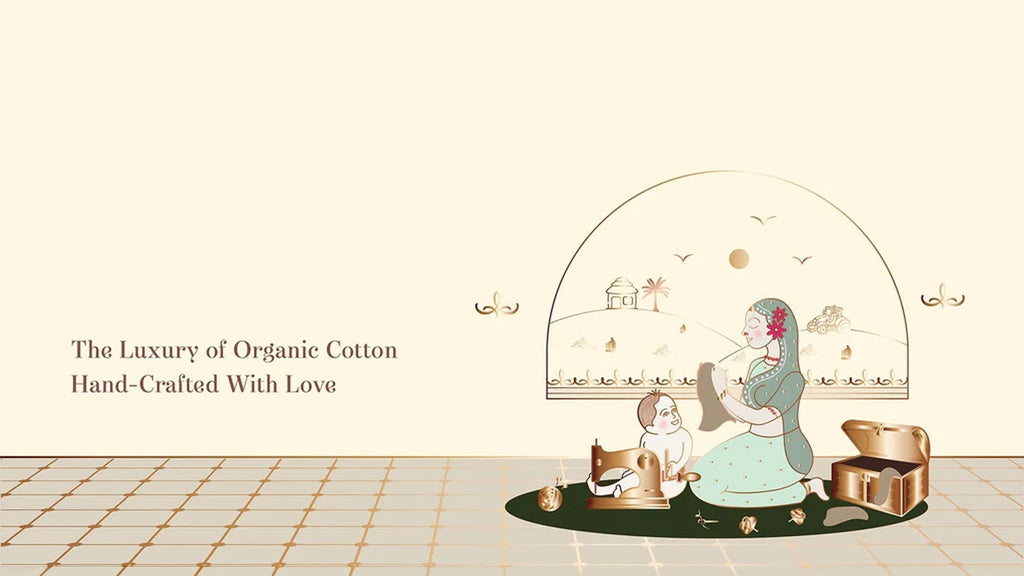
5 Best Summer Clothing for Baby Boys
With the summer being hotter, dressing your baby boy in comfortable and stylish outfits becomes a priority for many parents. Choosing the right summer clothing can keep your baby cool during the hotter months and ensure they look adorable and comfortable all the time. In this blog, we will explore essential summer clothing for baby boys, considering the delicate nature of their skin and the need for mobility and comfort.
Summer Care for Babies
Summers can be a challenging time for babies due to their sensitive skin and vulnerability to heat. Lightweight and breathable fabrics are key here; they allow air circulation and prevent overheating. Additionally, choosing outfits with easy access for diaper changes and made from soft materials are essential tips for both comfort and convenience.
5 Best Summer Clothing for Baby Boys
1. Cotton Linen Romper Set

The Cotton Linen Romper Set is a top choice for any summer occasion. This outfit includes a soft shirt paired with a romper, making it ideal for both indoor play and outdoor gatherings. The fabric's blend ensures it is lightweight and breathable, providing your baby comfort throughout the day.
2. Checkered Shirt with Off-White Cotton Linen Romper Set

The elegance of the Off-white Cotton Linen Romper Set lies in its gentle fabric that ensures your baby's comfort. Accompanied by a stylish checkered shirt, this outfit is perfect for more formal summer events or family photoshoots, keeping your little one both cool and charming.
3. Embroidered Shirt with Trouser Set

For special occasions, the Embroidered Shirt with Trouser Set stands out with its detailed embroidery and high-quality Tencel fabric. The material is renowned for its softness and breathability, ideal for a baby's sensitive skin. The notch collar and botanical Aari hand embroidery enhance the outfit's elegance, making your baby boy the star of any event.
4. Overlap Knotted Bodysuit

The Overlap Knotted Bodysuit is designed for ultimate comfort and flexibility. It features an adjustable knot detail that not only adds style but also allows for easy size adjustments as your baby grows. The breathable fabric ensures your baby stays cool, making it perfect for playtime or naptime.
5. Short Sleeves Baby Bodysuit Set

This ensemble is the epitome of convenience and comfort. The Short Sleeves Baby Bodysuit Set includes a bodysuit with snap buttons for easy dressing and undressing. Accompanied by a matching cap, mittens, and booties, it provides a complete outfit that keeps your baby protected and comfortable during the hot days, whether indoors or out.
Things to Consider Before Buying Summer Clothing for Baby Boys
When buying summer clothes for baby boys, keep a few things in mind to make sure they are comfortable and practical. First, choose baby clothes made of light and airy fabrics like cotton, which helps keep your baby cool and comfy. Look for clothes with simple snaps or zippers, which make changing diapers and clothes easier. It's also good to choose outfits that can protect your baby from the sun, or you can add a sun hat to shield them on sunny days. Pick clothes that are easy to wash since babies often get dirty during summer play.
Additional Tips
-
Fabric First
Always choose fabrics that are soft, breathable, and lightweight, such as cotton and linen. -
Protection is Key
For sunny days, ensure the outfit covers sensitive areas without overheating. Adding a lightweight hat can protect your baby's face and neck from the sun. -
Ease of Use
Opt for garments with snaps and zippers for easy changes. -
Layer Smartly
Even in summer, evenings can get chilly. Have a light sweater or jacket on hand in case the temperature drops.
Dressing your baby boy in comfortable, breathable, and stylish clothing is essential during the summer. By choosing the right fabrics and styles, you can ensure your baby enjoys the summer safely and in great spirits. Whether it's a day at the park, a special occasion, or just a comfortable day at home, these outfits will keep your little one cool and adorable.



